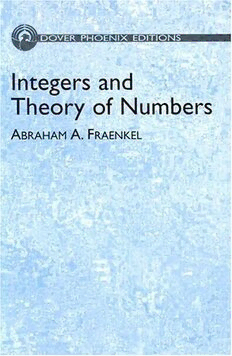
Integers and Theory of Numbers PDF
Preview Integers and Theory of Numbers
Lh3MC w DOVER PHOENIX EDITIONS Integers and Theory of Numbers A A. F braham raenkel Integers and Theory of Numbers Integers and Theory of Numbers A A . F b r a h a m r a e n k e l Dover Publications, Inc. Mineóla, New York DOVER PHOENIX EDITIONS Bibliographical Note This Dover edition, first published in 2004, is an unabridged and unaltered republication of the work first published in 1955 as Number Five in The Scripta Mathematica Studies, published by Scripta Mathematica, Yeshiva University, New York. Library of Congress Cataloging-in-Publication Data Fraenkel, Abraham Adolf, 1891-1965. [Mavo La-mathematikah. English] Integers and theory of numbers / Abraham A. Fraenkel.—Dover ed. p. cm. — (Dover phoenix editions) Originally published: New York : Scripta Mathematica, 1955 in series: Scripta mathematica studies ; v. 5. Includes index. ISBN 0-486-49588-4 1. Number theory. I. Title. II. Series. QA241.F713 2004 512.7—dc22 2004040886 Manufactured in the United States of America Dover Publications, Inc., 31 East 2nd Street, Mineola, N.Y. 11501 Table o f Contents PAGE Chapter I. Natural Numbers as Cardinals............ 1-11 1. The Positional Notation, 1 2. The Concept of Cardinal Number, 4 3. The Ordering of Numbers According to Magnitude, 9 Chapter II. Natural Numbers as Ordinals............. 12-24 1. Peano’s Axioms, 12 2. The Independence of the Axioms for Ordinals, 14 3. Mathematical Induction. Addition and Multiplica tion, 17 4. The Relation of Ordinals to Cardinals, 21 Chapter III. Theory of Numbers................................ 25-58 1. Prime Numbers and Their Distribution, 26 2. Partition of the Circle, 38 3. Fermat’s Simple and Last Theorems. The Concept of Congruence, 41 4. Perfect Numbers and Amicable Numbers, 47 5. Algebraic and Ideal Numbers, 52 Chapter IV. Rational Numbers...................................... 59-86 1. Positive Fractions, 59 2. Negative Integers, 68 3. The Field of Rationals, 72 Appendix....................................................................................... 87-100 Index of Terms...................................................................... 101 Index of Proper Names........................................................ 101-102 Preface T HIS VOLUME is essentially a translation of the first part of my Hebrew book Mavo LeMathematika1 (.Intro duction to Mathematics), but quite a number of modifications and additions have been incorporated. Two volumes of similar size, nature, and purpose are plan ned for publication during the next few years. One will deal with the fundamental concepts of algebra (group, ring, field) and their role in the extension of the number concept to real, complex, and hypercomplex numbers; the other will present and discuss the theory of sets, in particular trans- finite cardinal and ordinal numbers. These volumes developed from talks in the adult educa tion program given by the author in towns and rural settle ments of Palestine (now Israel) from 1929 on. Conse quently, the subject of the present volume and its treatment meet the needs, abilities, and interests of gifted high school students, of college freshmen, and, indeed, of laymen who are interested in knowing what mathematics really deals with—a question whose answer may have been concealed rather than revealed by the presentation in their classes. I wish to express my sincere thanks to Professor Jekuthiel Ginsburg without whose efforts the publication of the volume would not have been possible. Jerusalem, Israel Abraham A. Fraenkel Hebrew University 1 Vol. I, Jerusalem, 1942; vol. II, Jerusalem, 1954. These two volumes contain five parts which deal with the following topics: integers and theory of numbers; the extension of the number-concept, including groups, rings, fields, and a survey of algebra; analysis; theory of sets; geometry. A sup plementary volume which deals with the foundations of mathematics is in preparation. CHAPTER I N atural Numbers as Cardinals WE ARE here concerned with the nature of the positive integers which are known also as natural numbers. Contemporary mathematical opinion follows that of previous centuries in regarding these numbers as the keystone of the mathematical structure. In the words of W eyl: “ Mathematics is entirely dependent, even with respect to the logical forms of its exposition, upon the nature of the natural numbers.” However, unlike our predecessors of only half a century ago, most modern mathematicians do not think of mathematics as be ginning with the natural numbers and proceeding thence to the develop ment of various branches. The latest views rather tend to assign to integers a middle position in the structure of the science. The lower portions are devoted to the foundations of mathematics which are es tablished in the general theories of relation, order, sets, groups, fields etc. as well as of logic, while the various mathematical disciplines, such as theory of numbers, algebra, theory of functions and also most parts of geometry, start from the level of natural number. It should be noted, however, that even today a significant group of mathematicians believe that it is impossible to develop the natural numbers from more fundamental concepts and that we must regard them as emerging from the very nature of the human mind or even as objects which are im posed upon us regardless of our will. This last view has been expressed in a famous dictum of Kronecker1 (1823-91): God created the integers, the rest is work of man. 1. The Positional Notation Before proceeding with a study of natural numbers it is appropriate to devote a few words to their notation, that is, to the numeral system. The difficulty involved in the notation of numbers arises from the fact that infinitely many numbers must be represented by means of a finite array of symbols. Moreover, we make the following two demands 1 See Math. Annalen, Vol. 43, 1893, p. 15. 1
